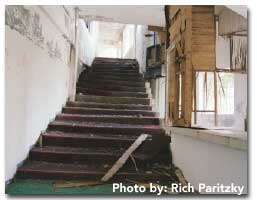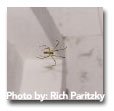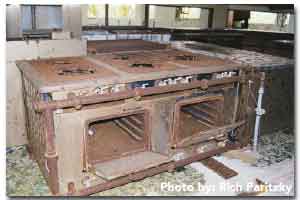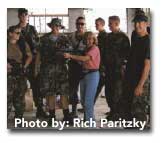|
|
- Motels, Hotels, and Other Spooky Things |
|
The Japanese are very superstitious people. They believe in spirits and have symbols and ceremonies to invite or discourage the spirits into their lives. The Obon festival is one of the larger celebrations to honor the spirits of their deceased relatives. (See Week Two) Another celebration to the spirits is the Tug of War contest that takes place the second weekend in October. A rope weighting 40 tons and extending 630 feet in length is used for the celebration. The rope, made of rice straw, is woven by the Okinawans and takes about a year to compete. The ceremony is a request of the spirits to bring the people good crops. Bells and whistles are used to call the bugs out of the crops and to ask the rain gods to bring rain to the fields. The main street in downtown Naha is blocked off for the celebration and anyone attending can take their turn pulling the rope. When the rope pull is over pieces are cut from the rope and participants can take the pieces home. It is said that if you hang a piece of the rope over your door it will bring good luck for the coming year. I have my piece of rope hanging over my door. You can see shisa lion dog figures on rooftops and in front of homes. These strange looking statues appear in pairs. One has his month open and the other has his mouth shut. It is believed that the lion with his month open brings in the good spirits and the one with the month closed keeps out the bad spirits. Ishaigantuu or stone tablet is a shrine used to ward off evil spirits. It is placed at intersections and dead end roads to protect the people who live on the roads. A special shrine in the kitchen of the Japanese house celebrates Hinukan, the fire god. The shrine, three small stones placed near the hearth, honors the fire god. The oldest woman in the house offers prayers to Hinukan for continued fire to heat the food to feed the family. The numbers four and nine are considered unlucky. The number 4 in Japanese is pronounced "shi" which means death and the number 9 is pronounced "ku" which is associated with the meaning of suffering. Both of the numbers are avoided when numbering rooms and floors in hotels and motels. A local Okinawan businessman built it in the early 1980's. During the construction of the hotel, several of his workers died for no apparent reason. The man's son became ill and he died too. It was discovered that the hotel was being built on top of some tombs that were located on the hillside. Okinawans will build around or next to tombs but never on top of them. When the man's son died, the man abandoned the construction and left the structure and everything in it as it was. The story goes that the spirits from the tombs haunt the hotel. We decided that we needed to explore this magnificent place. We also decided it would be more fun and a lot safer to take some friends along. We invited five other faculty members over to our place for Sunday breakfast and a tour of the abandoned hotel. The real thrill of the day was the tour through the abandoned hotel. The structure was designed to represent a small village and has a narrow street running through the area with the hotel buildings on both sides. We entered one end of the buildings on the right and started our way through the structure. There was a long passageway that looked like it could have been a hotel hallway. The rooms off to one side were open with a step up. The design looks like that of a tatami room. Tatami rooms have rice paper sliding doors and tatami mats (thick straw mats) on the floor and are often used for sleeping. We saw chairs and mattresses here and there that were damaged and well worn from years of exposure to the elements. Out of the windows to our right, down a long slope, was a swimming pool with what looked like a long staircase leading down to a patio area. The gazebo has a stone staircase going around the outside. Following the staircase up several floors you arrive at the top of the structure. What a view we had from there. You could see the Pacific Ocean on one side and the China Sea on the other. About a mile from our place, in the opposite direction from the abandon hotel, is another small group of buildings known as the Love Motel. Now, the story goes that many married couples use these motels for privacy. The houses that the locals live in are built very close together, many with open entrances. The interior walls are often made of thin rice paper giving little privacy to the couple of the house. When you check into the Love Motel you drive into a private parking place. A gate comes down to cover your car's license plate providing even more privacy to customers. When you are ready to leave you push a button which alerts the motel manager. A bill is delivered through a slot in your door and you leave your yen in the room. You then drive off without ever seeing a motel employee. We have not visited this motel yet. From the day I arrived on this island I have experienced déjà vu more that I normally do. When someone is talking to me or I am close enough to hear a conversation between others, I know what they are going to say before they say it. I am aware of the feeling that I have been here before. I will see things that I recognize as familiar but I don't know why they look familiar because I can't remember seeing them before. We will travel around the island and I will know what is beyond the next curve in the road before we get around the curve. Maybe the many spirits on this island are trying to tell me something!!! As Halloween approaches and all the ghosts and spirits prepare for a night of frolic, I think I will stay in and sip some green tea. HAPPY HALLOWEEN
Map of Japan - provided by the CIA
Note: Not all pictures were not taken by my mom. Some pictures were found on the internet. |
|
 Across the street from our apartment, nestled into a hillside, is a large, abandoned hotel. The structure takes up most of the hillside and is overgrown with vines and tree branches. The dark windows draw your attention and make you want to see more. On the top of the hill is a gazebo like structure (part of the hotel) where you can view the whole island. Some people say this hotel is haunted.
Across the street from our apartment, nestled into a hillside, is a large, abandoned hotel. The structure takes up most of the hillside and is overgrown with vines and tree branches. The dark windows draw your attention and make you want to see more. On the top of the hill is a gazebo like structure (part of the hotel) where you can view the whole island. Some people say this hotel is haunted. The hotel sits next to the Nakagusuku Castle ruins. To enter the hotel without walking through the overgrown jungle where the Habu (snakes) live you have to go into the Nakagusuku Castle site. The entrance fee was 300 yen ($3.00) so we explored the castle ruins while we were there. The castle was built in the 1st half of the 15th century by Lord Gosamaru. Lord Gosamaru was a famous warrior and well known as an architect of castles. The castle site is two kilometers straight up from an old trading port on the Pacific Ocean. It was built to protect the district from any invasions from the south. It sits on the top of a hill and is sounded by stone walls that still exist today. The stone was piled one on top the other without any substance holding the stone together. The ruins still display the large arched openings or gates in the stonewalls that served as an entrances into the inner castle grounds. The site had 6 stone citadels (towers) surrounding the structure that were used as lookouts.
The hotel sits next to the Nakagusuku Castle ruins. To enter the hotel without walking through the overgrown jungle where the Habu (snakes) live you have to go into the Nakagusuku Castle site. The entrance fee was 300 yen ($3.00) so we explored the castle ruins while we were there. The castle was built in the 1st half of the 15th century by Lord Gosamaru. Lord Gosamaru was a famous warrior and well known as an architect of castles. The castle site is two kilometers straight up from an old trading port on the Pacific Ocean. It was built to protect the district from any invasions from the south. It sits on the top of a hill and is sounded by stone walls that still exist today. The stone was piled one on top the other without any substance holding the stone together. The ruins still display the large arched openings or gates in the stonewalls that served as an entrances into the inner castle grounds. The site had 6 stone citadels (towers) surrounding the structure that were used as lookouts.  As we continued along the passageway we saw banana spiders hanging from their webs in the window openings and doorways. Banana spiders are about the largest spider I have ever seen. All of a sudden we heard a gun shot! That stopped me dead in my tracks. After I recovered from the initial shock I hollowed out, "Hello". I looked up ahead and there stood three marines dressed in their camouflage uniforms, faces blackened and holding guns. I said, "Hello" again and explained to them that we were just visiting civilians. They hollowed something out the window about civilians in the area and we heard all this scurrying out in the bushes.
As we continued along the passageway we saw banana spiders hanging from their webs in the window openings and doorways. Banana spiders are about the largest spider I have ever seen. All of a sudden we heard a gun shot! That stopped me dead in my tracks. After I recovered from the initial shock I hollowed out, "Hello". I looked up ahead and there stood three marines dressed in their camouflage uniforms, faces blackened and holding guns. I said, "Hello" again and explained to them that we were just visiting civilians. They hollowed something out the window about civilians in the area and we heard all this scurrying out in the bushes. We approached the soldiers and realized they were very friendly. They explained to us that they come out to the abandoned hotel on the weekends to play war games with BB guns. There were about 20 of them in the bushes and on the rooftops. One of the soldiers was kind enough to give us a private tour of the hotel. He took us through small passageways and tunnels leading into other areas that looked like ballrooms, exercise rooms, a bar room and a grand staircase. We happened upon a kitchen with the stoves still in place. The tile on the kitchen floor is the same mosaic we have in the front entrance to our apartment. Must have been a popular tile.
We approached the soldiers and realized they were very friendly. They explained to us that they come out to the abandoned hotel on the weekends to play war games with BB guns. There were about 20 of them in the bushes and on the rooftops. One of the soldiers was kind enough to give us a private tour of the hotel. He took us through small passageways and tunnels leading into other areas that looked like ballrooms, exercise rooms, a bar room and a grand staircase. We happened upon a kitchen with the stoves still in place. The tile on the kitchen floor is the same mosaic we have in the front entrance to our apartment. Must have been a popular tile.  We left the hotel structure and proceeded up the roadway to the gazebo on top of the hill. On the first floor of the gazebo we ran into the other marines who had built a fire and were roasting hot dogs for lunch. I asked them if I could take their picture and they all agreed. Richie suggested I get in the picture and one of the soldiers handed me his gun. They all got a big chuckle out of the fact that I didn't know how to hold a gun. After a quick lesson we took the picture. Richie told me later that they were probably also chuckling because I called their weapons guns. Soldiers call their guns weapons. I won't make that mistake again.
We left the hotel structure and proceeded up the roadway to the gazebo on top of the hill. On the first floor of the gazebo we ran into the other marines who had built a fire and were roasting hot dogs for lunch. I asked them if I could take their picture and they all agreed. Richie suggested I get in the picture and one of the soldiers handed me his gun. They all got a big chuckle out of the fact that I didn't know how to hold a gun. After a quick lesson we took the picture. Richie told me later that they were probably also chuckling because I called their weapons guns. Soldiers call their guns weapons. I won't make that mistake again. During World War II many Okinawans used the caves on the island as hotels. The invasion on this island was devastating and destructive. The local people ran from their homes to the many underground caves for protection. Some of the people in the caves committed suicide rather than risking capture by the Americans. Local stories tell of the spirits of the dead still roaming the caves and seeking a proper burial by their relatives. Some say they have seen the ghosts walking the caves at night or have heard their cries and screams. Others says that Americans should steer clean of the caves and other sites on the island because the angry spirits still want revenge on the Americans who invaded their island during World War II.
During World War II many Okinawans used the caves on the island as hotels. The invasion on this island was devastating and destructive. The local people ran from their homes to the many underground caves for protection. Some of the people in the caves committed suicide rather than risking capture by the Americans. Local stories tell of the spirits of the dead still roaming the caves and seeking a proper burial by their relatives. Some say they have seen the ghosts walking the caves at night or have heard their cries and screams. Others says that Americans should steer clean of the caves and other sites on the island because the angry spirits still want revenge on the Americans who invaded their island during World War II.